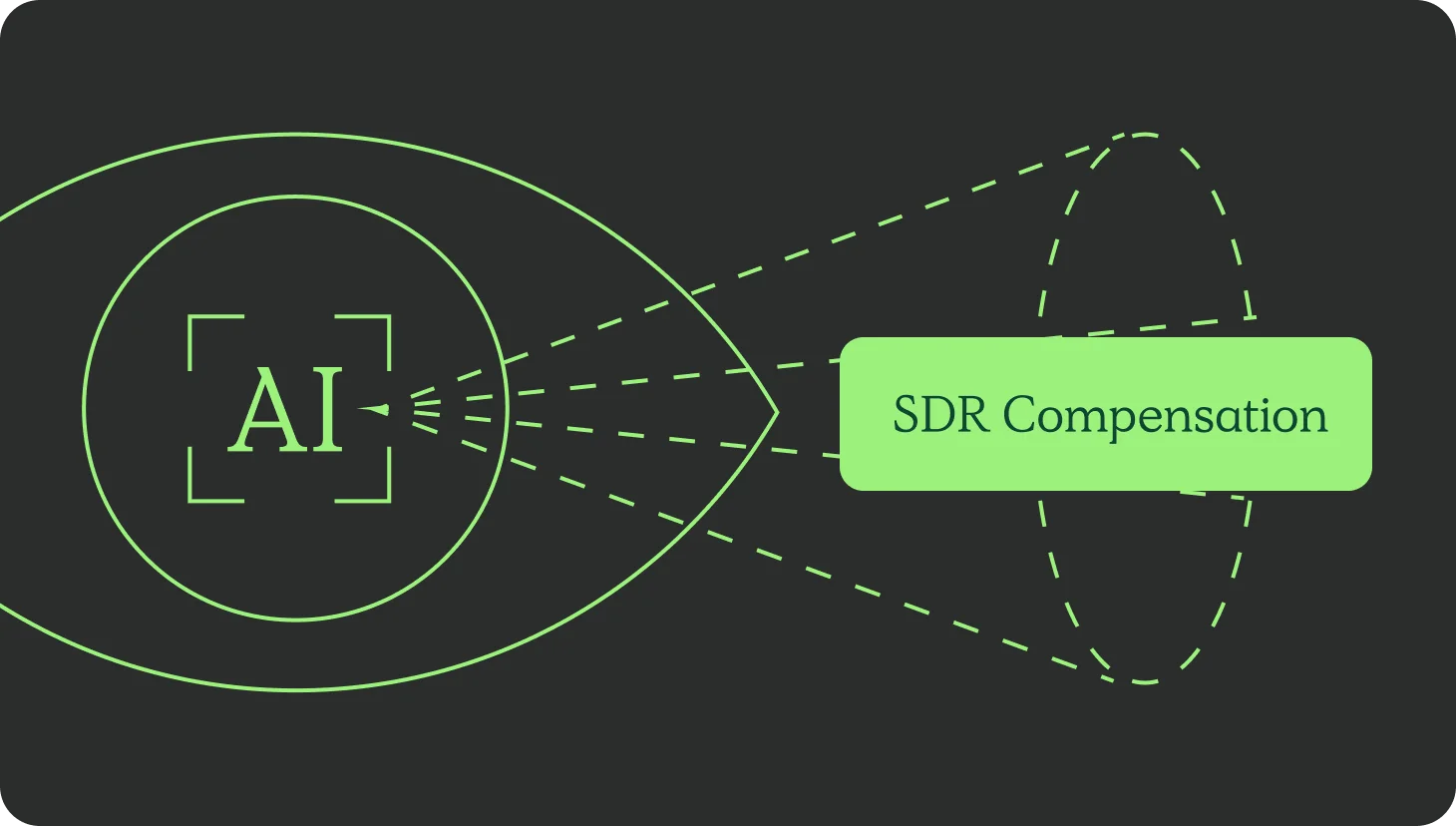QuotaPath Director of Demand Generation Bret Lehnhof authored this blog post on adjusting SDR compensation for today’s technological landscape.
With the increased use of technology to identify target accounts and automate sales tasks, the role of an SDR (Sales Development Representative) has evolved.
For instance, advancements in AI have automated many of the traditional roles of an SDR such as identifying potential leads, crafting personalized email copy, and even responding to emails and scheduling meetings.
Try QuotaPath for 30-days
Try the most collaborative solution to manage, track and payout variable compensation. Calculate commissions and pay your team accurately, and on time.
Try for FreeStill, SDRs remain a critical piece of your growth engine because the technology needs an orchestrator.
More importantly, businesses will always require human relationships.
However, the introduction of AI and sales enablement technology have shifted the way we should think about compensating SDRs.
Traditionally, SDRs have followed compensation plans that pay based primarily on booking meetings for account executives. That means for any lead that they set a meeting for with their account executive, they earn a bonus. Think $200 per demo set.
But as automation has replaced some of the responsibilities that SDRs used to be in charge of, how can you re-imagine their compensation plans to fit today’s times better?
Why use an SDR compensation plan:
An SDR compensation plan is essential because it aligns incentives with the role’s evolving responsibilities, ensuring SDRs stay motivated and productive.
As automation takes over tasks like lead identification and email outreach, compensation should shift to reward higher-value contributions, such as engaging prospects in meaningful conversations, qualifying leads effectively, and driving pipeline growth.
Additionally, a well-structured plan helps retain top talent, encourage skill development, and ensure SDRs remain a valuable part of the sales process. Ultimately, SDR compensation should evolve to reflect the strategic, relationship-building aspects of the role that technology cannot replace.
Below are three things to consider when thinking through SDR compensation plans in the age of AI:
1. Keep your eye on the revenue
Even though AI has changed (and continues to change) the game, SDRs still need to drive revenue for the business. Therefore, compensation plans that incentivize your SDRs to drive revenue remain in full effect.
Focus on plans that reward your SDRs for booking demos and giving them a piece of the pie for when the leads they pass convert to customers. Adding a “Closed-Won Commission” component to a compensation plan drives urgency for the SDR to create a very human first impression and stand out from the AI crowd to build real relationships needed to win.
Create Compensation Plans with confidence
RevOps, sales leaders, and finance teams use our free tool to ensure reps’ on-target earnings and quotas line up with industry standards. Customize plans with accelerators, bonuses, and more, by adjusting 9 variables.
Build a Comp Plan2. Reward technology adoption
AI and sales enablement tools are here to stay and are only going to improve. The SDR that stays on the frontline of tech advancements and creatively implements new practices will rise to the top.
Consider developing a SPIF that rewards the SDR with the most successful AI integration into their prospecting initiatives.
3. Incentivize efficiency
Automation has exponentially increased the speed at which an SDR can prospect into accounts. It’s also enabled SDRs to tackle an enormous amount of daily sales activities.
While tracking SDR activity levels is a leading performance indicator (view our sales funnel calculator), you should prioritize efficiency. An effective SDR compensation plan should consider sales opportunity conversion rates and how many of those opportunities move to qualified or closed-won stages.
Reward the SDR that creates meaningful conversations with prospects that are ready to buy. Consider creating a SPIF for the SDR that has the shortest closed-won sales cycle. You could also SPIF for the SDR with the highest opportunity conversion rate.
How to Design an SDR Compensation Plan
Designing an effective SDR compensation plan requires aligning incentives with both business objectives and the evolving role of SDRs. Given the increasing use of AI and automation, compensation should go beyond just meetings booked and reflect SDRs’ contributions to pipeline growth and sales enablement.
Key considerations when structuring an SDR comp plan:
- Balance Base Salary and Variable Pay: Traditional SDR compensation often follows a 60/40 or 70/30 split between base salary and variable earnings. However, the split may need adjustment based on how SDRs contribute beyond just setting meetings.
- Incentivize Pipeline Impact, Not Just Meetings Booked: While demo bookings remain a core metric, consider rewarding SDRs for qualified opportunities that progress further in the funnel rather than just initial meetings.
- Incorporate Multi-Touch Contribution Metrics: Since automation now plays a role in outreach, SDRs should be compensated for strategic engagement, such as nurturing high-value accounts, facilitating multi-channel outreach, or assisting with outbound personalization.
- Set Clear, Attainable Goals: Compensation should be based on realistic quotas informed by historical performance, industry benchmarks, and the effectiveness of AI-assisted outreach.
- Offer Bonuses for High-Quality Opportunities: Reward SDRs for deals that progress to later sales stages (e.g., opportunities that reach proposal or close-won status) rather than simply paying for booked demos.
By shifting the compensation model from a volume-based approach to a value-driven one, businesses can ensure SDRs remain motivated and focused on impactful sales activities rather than just chasing meeting quotas.
SDR Compensation Plan Examples
Depending on your business model, sales motion, and use of automation, here are a few SDR compensation plan structures to consider:
- Traditional Meeting-Based Plan:
- Base Salary: 60-70% of total comp
- Variable Pay: Paid per demo set (e.g., $200 per completed demo)
- Best for: High-volume outbound teams with lower ACV deals
- Qualified Opportunity Plan:
- Base Salary: 60-70% of total comp
- Variable Pay: Compensation based on the number of qualified opportunities rather than just meetings booked (e.g., $500 per opportunity that reaches a defined pipeline stage)
- Best for: Teams focused on pipeline quality rather than raw meeting volume
- Revenue-Based Plan:
- Base Salary: 50-60% of total comp
- Variable Pay: SDRs earn a percentage of revenue from deals they sourced (e.g., 1-2% of closed-won revenue)
- Best for: Organizations with longer sales cycles and higher ACV deals
- Hybrid Compensation Plan:
- Base Salary: 60-70% of total comp
- Variable Pay: Mix of meeting bonuses, opportunity-based rewards, and revenue share
- Best for: Businesses looking to balance activity metrics with sales impact
Each model should be tailored to reflect how SDRs drive pipeline growth in today’s AI-assisted sales environment. By rewarding strategic engagement instead of just raw activity, companies can create SDR compensation plans that motivate reps while adapting to modern sales strategies.
Final Thoughts
In summary, AI and sales automation are here to stay.
However, SDRs remain a crucial role in orchestrating the technology and providing human-to-human interaction necessary to drive revenue.
As tech advances, so should the way we think about compensating our SDR teams.
For additional resources to support the growth of your SDR team, check out the following blogs:
- 7 lessons we learned after building our first SDR team
- SDR compensation plans to consider for 2023
- How to set bonus and commission rates for SaaS SDRs
Ready to automate sales compensation management and commission tracking? Sign up for a free 30-day trial or schedule time with our team to learn more.



